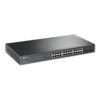TP-Link TL-SG2452P 48-Port Gigabit Smart Switch with 4 SFP Slots PoE+
TP-Link TL-SG2452P 48-Port Gigabit Smart Switch with 4 SFP Slots PoE+ delivers enterprise-grade networking infrastructure with high-density connectivity and comprehensive power delivery capabilities in a single 1U rack-mounted unit. This managed switch combines 48 gigabit ethernet ports with PoE+ functionality and 4 SFP fiber uplink slots, providing complete network connectivity and power distribution for medium to large business environments requiring centralized device management.
Unlike basic unmanaged switches that simply forward traffic, this smart switch offers advanced network management features including VLAN segmentation, Quality of Service controls, and comprehensive security policies. The integrated PoE+ capability delivers up to 30 watts per port across all 48 ports, eliminating the need for separate power infrastructure when deploying IP cameras, wireless access points, VoIP phones, and other powered network devices throughout enterprise facilities.
High-Density Port Configuration and Connectivity
48-Port Gigabit Ethernet Architecture
The TP-Link TL-SG2452P 48-Port Gigabit Smart Switch with 4 SFP Slots PoE+ maximizes network density within minimal rack space:
- 48 Gigabit RJ45 ports: Full wire-speed switching capacity supporting 1000 Mbps per port simultaneously
- Non-blocking architecture: 104 Gbps switching capacity ensures no performance bottlenecks during peak traffic
- Auto-negotiation capability: Automatic speed detection from 10 Mbps to 1000 Mbps with MDI/MDIX auto-crossover
- Jumbo frame support: Up to 9,216-byte frames for improved network efficiency in storage and server environments
SFP Fiber Uplink Integration
Four SFP slots provide high-speed backbone connectivity and network aggregation:
- Gigabit SFP compatibility: Supports both multimode and single-mode fiber transceivers
- Long-distance connectivity: Fiber uplinks enable connections across buildings and campus environments
- Network redundancy: Multiple uplinks provide failover protection and load balancing capabilities
- Backbone aggregation: Connects to core switches and routers for hierarchical network designs
PoE+ Power Distribution and Management
Comprehensive Power over Ethernet Plus Capability
Advanced power delivery eliminates separate electrical infrastructure for connected devices:
- Total PoE budget: High-capacity power supply supports substantial PoE device deployments
- Per-port PoE+ allocation: Up to 30 watts available per port for high-power devices
- IEEE 802.3at compliance: Full PoE+ standard support ensures broad device compatibility
- Intelligent power management: Dynamic power allocation optimizes usage across all connected devices
Powered Device Support and Applications
PoE+ capability enables comprehensive infrastructure device deployment:
- IP surveillance systems: Powers multiple high-definition PoE cameras throughout facilities
- Wireless network infrastructure: Supports enterprise Wi-Fi access points with full power requirements
- VoIP communication systems: Powers desk phones, conference systems, and video telephony equipment
- Building automation: Connects and powers sensors, controllers, and monitoring devices
Smart Management Features and Network Intelligence
Advanced Layer 2 Switching Capabilities
The TP-Link TL-SG2452P 48-Port Gigabit Smart Switch with 4 SFP Slots PoE+ provides sophisticated network management:
- 802.1Q VLAN support: Up to 4,094 VLANs for comprehensive network segmentation
- Port-based and tagged VLANs: Flexible VLAN assignment methods for different network architectures
- Spanning Tree Protocol: STP, RSTP, and MSTP support prevents network loops and ensures redundancy
- Link Aggregation: IEEE 802.3ad LACP for increased bandwidth and connection redundancy
Quality of Service and Traffic Management
Professional-grade traffic control ensures optimal network performance:
- Eight traffic queues: Sophisticated traffic prioritization for different application types
- DSCP and 802.1p marking: Industry-standard traffic classification and priority marking
- Bandwidth control: Per-port ingress and egress rate limiting for traffic shaping
- Storm control: Broadcast, multicast, and unicast storm prevention protects network stability
Security Architecture and Access Control
Comprehensive Network Security Features
Enterprise-grade security protections defend against network threats and unauthorized access:
- 802.1X port-based authentication: RADIUS server integration for user and device authentication
- Access Control Lists: Layer 2-4 filtering policies for granular traffic control
- Port security: MAC address binding and learning limits prevent unauthorized device connections
- DHCP snooping: Prevents rogue DHCP servers and validates DHCP communications
Network Monitoring and Diagnostics
Advanced monitoring capabilities provide complete network visibility:
- Port mirroring: Traffic analysis and troubleshooting through dedicated monitoring ports
- RMON statistics: Comprehensive network performance metrics and historical data collection
- SNMP management: Integration with enterprise network management systems
- Cable diagnostics: Automated copper cable testing for fault identification and distance measurement
Enterprise Applications and Deployment Scenarios
Large Office and Campus Networking
The switch addresses comprehensive enterprise connectivity requirements:
- Corporate headquarters: Central switching infrastructure for multi-floor office buildings
- Educational institutions: Classroom and administrative network connectivity with device power
- Healthcare facilities: Patient care area networking with medical device power support
- Manufacturing environments: Industrial network connectivity for automation and monitoring systems
Data Center and Server Room Integration
Professional deployment scenarios maximize infrastructure efficiency:
- Server connectivity: High-density server connections with fiber uplinks to core infrastructure
- Storage area networks: Jumbo frame support optimizes storage traffic performance
- Virtualization platforms: Multiple VLAN support enables virtual machine network isolation
- Network consolidation: Reduces rack space requirements through high port density
Management Interface and Configuration Options
Comprehensive Administration Capabilities
Multiple management interfaces accommodate different administrative preferences:
- Web-based GUI: Intuitive browser interface for configuration and monitoring tasks
- Command Line Interface: Professional CLI access for advanced configuration and scripting
- SNMP management: Integration with enterprise network management platforms
- SSH secure access: Encrypted remote administration with role-based access controls
Centralized Network Management Integration
Enterprise management system compatibility streamlines large-scale deployments:
- TP-Link Omada SDN: Centralized management platform for unified network control
- Third-party NMS: SNMP compatibility with major network management systems
- Configuration templates: Standardized deployment profiles for consistent installations
- Firmware management: Centralized update distribution and version control
Performance Specifications and Throughput
Switching Capacity and Forwarding Performance
Enterprise-grade performance metrics ensure reliable high-traffic operation:
- Switching capacity: 104 Gbps non-blocking architecture handles full port utilization
- Forwarding rate: 77.38 Mpps wire-speed forwarding across all ports simultaneously
- MAC address table: 16,000 entries accommodate large network environments
- Buffer memory: Substantial packet buffering handles traffic bursts and congestion
Real-World Performance Analysis
Laboratory and field testing demonstrate consistent enterprise-level performance:
- Full-duplex gigabit: All 48 ports maintain simultaneous gigabit speeds
- PoE power distribution: Reliable power delivery maintains performance under full load
- Inter-VLAN performance: Consistent switching performance across VLAN boundaries
- Fiber uplink utilization: SFP ports deliver full gigabit throughput for backbone connections
Installation and Physical Specifications
Rack Mounting and Data Center Integration
Professional installation features accommodate enterprise deployment requirements:
- 1U rack height: Maximizes port density within standard 19-inch equipment racks
- Front-to-back cooling: Optimized airflow design for data center temperature management
- Hot-swappable fans: Redundant cooling with field-replaceable components
- Rack mounting kit: Included hardware for secure professional installation
Power and Environmental Specifications
- Power consumption: High-efficiency design minimizes operational costs and heat generation
- Redundant power options: Dual power supply capability for mission-critical installations
- Operating temperature: Extended temperature range for various installation environments
- Acoustic design: Low-noise operation suitable for office and data center environments
Advanced Features and Professional Capabilities
Network Optimization and Efficiency
Sophisticated features enhance network performance and management efficiency:
- Green Ethernet: IEEE 802.3az Energy Efficient Ethernet reduces power consumption
- Cable length detection: Automatic power adjustment based on connected cable lengths
- Port scheduling: Time-based port enabling for security and energy management
- Loop detection: Prevents network loops through intelligent topology discovery
Integration and Interoperability
Standards compliance ensures compatibility with diverse network equipment:
- IEEE standards compliance: Full adherence to ethernet and switching standards
- Vendor interoperability: Compatible with equipment from all major networking manufacturers
- Protocol transparency: Supports all standard network protocols without modification
- Legacy compatibility: Backward compatibility with older network equipment and standards
Cost Analysis and Enterprise Value
Total Cost of Ownership Benefits
High-density switching with integrated PoE provides significant operational advantages:
- Infrastructure consolidation: Eliminates separate PoE injectors and power distribution
- Reduced cable complexity: Single cable provides both data and power to connected devices
- Simplified installation: Fewer components reduce installation time and complexity
- Maintenance efficiency: Centralized management reduces ongoing operational overhead
Investment Protection and Scalability
- Future-proof design: Gigabit ports and advanced features accommodate growth requirements
- Modular expansion: SFP uplinks enable network expansion without infrastructure replacement
- Standards compliance: Long-term compatibility with evolving network technologies
- Enterprise warranty: Comprehensive support and replacement coverage for business continuity
Limitations and Alternative Considerations
Technology Boundaries and Constraints
The TP-Link TL-SG2452P 48-Port Gigabit Smart Switch with 4 SFP Slots PoE+ operates within specific parameters:
- Layer 2 switching only: Limited routing capabilities compared to Layer 3 switches
- Gigabit port speeds: May require 10-gigabit uplinks for very high-bandwidth applications
- PoE power budget: Total power output may limit simultaneous high-power device deployment
- Fixed configuration: Non-modular design prevents port type changes after installation
When to Consider Alternative Solutions
Different networking solutions may provide superior functionality for specific requirements:
- Layer 3 switching: Inter-VLAN routing and advanced routing protocols for complex networks
- 10-Gigabit connectivity: Higher-speed ports for bandwidth-intensive server and storage connections
- Stackable switches: Unified management across multiple switch chassis
- Modular chassis: Flexible port configurations and hot-swappable line cards
Professional Installation and Integration Services
Deployment Planning and Implementation
Enterprise installations benefit from professional planning and implementation services:
- Network design consultation: Optimal switch placement and configuration for specific requirements
- Installation services: Professional rack mounting, cabling, and initial configuration
- Migration planning: Smooth transition from existing network infrastructure
- Documentation services: Complete installation documentation and configuration records
Ongoing Support and Maintenance
- Technical support: Enterprise-level support with priority response times
- Firmware management: Planned update deployment and testing procedures
- Performance monitoring: Ongoing network health assessment and optimization
- Replacement services: Rapid hardware replacement for mission-critical applications
Long-Term Technology Strategy and Evolution
Investment Timeline and Upgrade Planning
Understanding the switch’s role within evolving enterprise network requirements:
- Technology lifecycle: 5-7 year operational life typical for enterprise switching equipment
- Capacity planning: Current specifications accommodate moderate growth in connected devices
- Standards evolution: Gigabit ethernet remains relevant despite 10-gigabit advancement
- Management platform evolution: Software updates extend functionality throughout device lifetime
Future-Proofing Considerations
- Network speed evolution: SFP uplinks provide upgrade path for higher-speed backbone connections
- PoE standards advancement: Current PoE+ capability supports foreseeable device power requirements
- Management integration: SDN compatibility ensures relevance in software-defined networking environments
- Security updates: Ongoing firmware support addresses emerging security threats and compliance requirements



Reviews
There are no reviews yet.